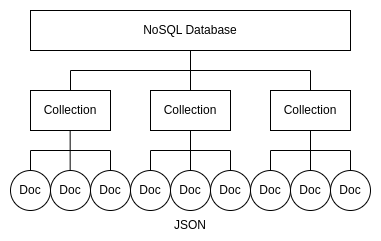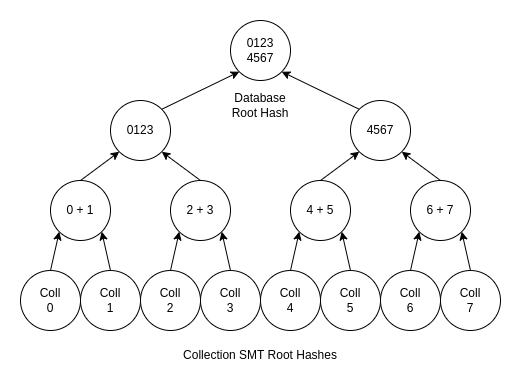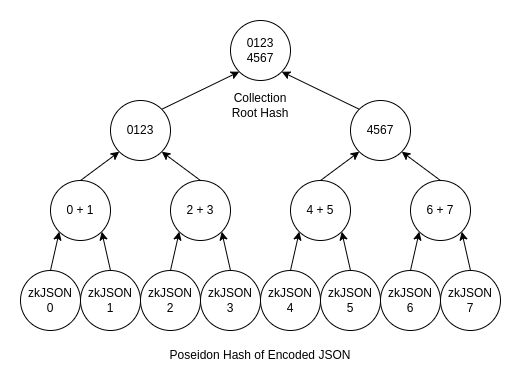Database Structure
The entire WeaveDB instance is represented as a self-contained gigantic JSON. Top-level keys are dirs, which contain a collection of docs. Self-contained means all the configurations and bookkeeping of the internal state are also within this JSON, which makes every aspect of the database verifiable by zero-knowledge proofs.
This JSON object is never loaded entirely into memory. Instead, the wdb-kv adapter stores each doc in the underlying kv storage (lmdb by default) and intelligently handles atomic state updates after every transaction. Atomic update means if something fails during a single transaction, nothing will be updated and the entire state of the database rolls back to the old one before starting the transaction.
const wdb = {
_: {
_: { index: 0 },
_config: { index: 1 },
users: {
index: 2,
auth: { "set:user": 0 },
triggers: { "inc_age": 0 }
},
posts: { index: 3, autoid: 2, auth: { "add:post": 0 } }
},
_config: {
info: {
i: 4,
ts 1759771428592,
id: "abc...",
owner: "xyz...",
hashpath: "xyz...",
dirs: 3 ,
max_doc_id: 184,
max_dir_id: 24,
max_doc_size: 256
},
schema_4: { type: "object" },
auth_4_0": { rules: [ "set:user", [["allow()"]]] },
indexes_4: { indexes: [[[ "name", "asc" ], [ "age", "desc" ]]] },
triggers_4_0: {
name "inc_age",
on: "create"
fn: [["update()", [{ age: { _$: ["inc"] } }, "users", "$doc"]]],
},
schema_5: { type: "object" },
auth_5_0": { rules: [ "add:post", [["allow()"]]] },
},
users: {
bob: { name: "Bob", age: 21 },
alice: { name: "Alice", age: 31 }
},
posts: {
A: { body: "Hello" },
B: { body: "World" }
},
...
}State transitions are handled in memory and queries are served at lightning speed by a rollup node, while WAL is sent to a HyperBEAM node. Validators download the WAL from the HyperBEAM node and compact the data with ARJSON, then upload the absolute minimum bits to an AO database process, which in turn commits the bits to Arweave permanent storage. The entire JSON structure is recoverable from the WAL, the AO process, or the bits stored on Arweave.
zkDB and Sparse Merkle Trees
The JSON structure is also represented by nested sparse merkle trees to provide novel zk provability with the zkJSON circuit. Some database constraints come from the accompanying zk circuit limitations.

DirID and DocID
Each dir has a key in the JSON, but the actual IDs are numeric, representing leaf positions in the zkDB merkle tree.

_/[dirname]/index assigns the lowest available leaf position, which means it's auto-incremental. For example, _ is 0, _config is 1, user is 2, and post is 3 from the DB instance above.
_config/info/last_dir_id keeps track of the current leaf position when dirs are added.
_config/info/max_dir_id restricts the maximum number of dirs in the DB, which is 2 to the power of the value. For example, max_dir_id=24 allows 2 ** 24 = 16777216 dirs. 24 is the number of levels in the merkle tree, so the number of leaves is 2 ** 24.
The following is the default auth rule for dir creation:
[
"set:dir",
[
["=$isOwner", ["equals", "$signer", "$owner"]],
["=$dir", ["get()", ["_config", "info"]]],
["=$dirid", ["inc", "$dir.last_dir_id"]],
["mod()", { index: "$dirid" }],
["update()", [{ last_dir_id: "$dirid" }, "_config", "info"]],
["allowif()", "$isOwner"],
],
]DocIDs are in base64url format rather than utf8, which are also converted to numeric values to fall into merkle tree leaf positions. So only A-Za-z0-9_- are allowed. For example, max_doc_id=184 means the tree has 184 levels, which contains 2 ** 184 leaves. If we convert the max position to base64url, 31 characters are allowed, which can contain WDB23.

AutoID
When executing an add operation, an auto-incremental docID will be assigned, which is tracked by _/[dirname]/autoid. The first docID will be A (= 0), the second docID will be B (= 1), and so on. You can assign arbitrary docIDs with other operations such as set, update, and upsert.
System Dirs
System dirs are prefixed by _ and are only updatable internally by the DB owner. The docs are not indexed, meaning you can only query directly by specifying a docid.
_ (underscore)
The _ dir keeps track of the dirs in the database. To add any docs, an entry for the dir must exist here. The configurations for dirs such as schema, auth, indexes, and triggers are stored separately in the _config dir due to zkJSON constraints (around 6000 characters worth of data for one JSON doc).
index: dir index of the leaf in the zkDB merkle treeauth: refs to auth rules in the_configdirtriggers: refs to triggers in the_configdir
_config
info: DB info and configs such as the AO processid,owner, anddirscountindexes_[dirid]: multi-field indexes for a dirschema_[dirid]: JSON schema for a dirauth_[dirid]_[auth_ref]: FPJSON auth rules for a dirtriggers_[dirid]_[trigger_ref]: a trigger for a dir
Private Dirs
There are private dirs excluded during the compaction process. These are prefixed by __.
__indexes__: B+ tree indexers (recomputable)__accounts__: tracking nonces to avoid replay attacks__meta__: tracking metadata such as hashpath and transaction height__wal__: copies of WAL sent to HyperBEAM and state changes (available for explorer)__priv_wal__: state changes of private dirs
Custom Dirs
The rest are the dirs added by the DB owner, such as users and posts for a social app.
You can use wdb-sdk to:
- create dirs
- set schema
- set auth rules
- add/remove multi-field indexes
- add/remove triggers
- set data (add / set / update / upsert / del / batch)
- get data (get / cget)
